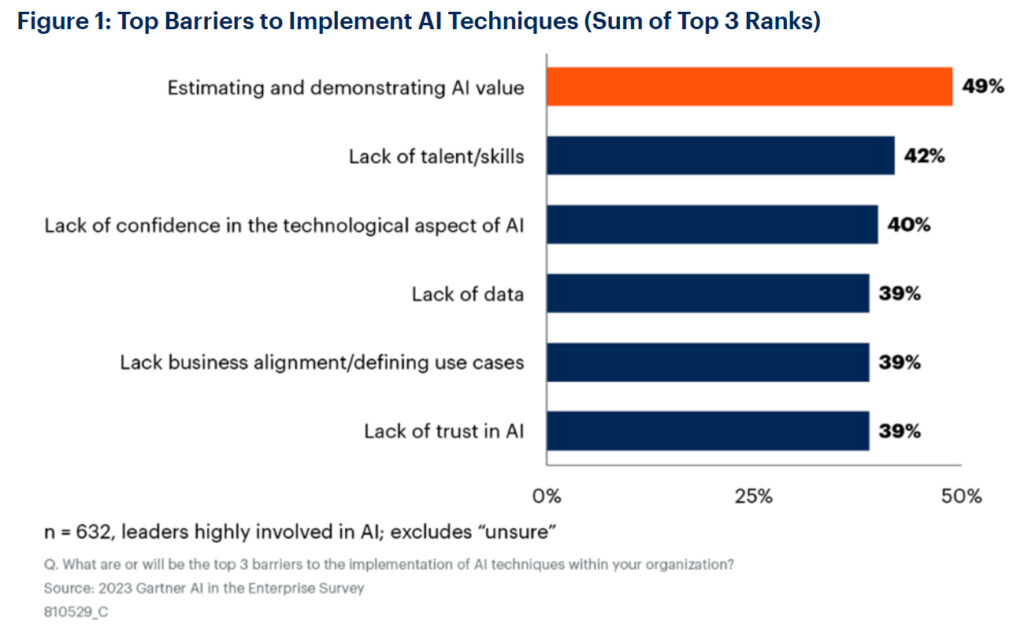A Gartner 2023 Gartner CIO and Technology Executive Survey revealed that even before ChatGPT, one-third of CIOs say their organisation had already deployed artificial intelligence (AI) technologies, and 15% more believe they will deploy AI within the following year.

"GenAI is acting as a catalyst for the expansion of AI in the enterprise," said Leinar Ramos, senior director analyst at Gartner. "This creates a window of opportunity for AI leaders, but also a test on whether they will be able to capitalise on this moment and deliver value at scale."
Recognising the high expectations CEOs and business unit leaders have on AI puts a heavier burden on the CIO to manage expectations and the reality of integrating emerging technology into existing operational processes – ensuring that nothing is disrupted and the company remains compliant with existing regulations in the interim.
But deciding how best to proceed means factoring AI into business value, risk, talent, and investment priorities, presenting a whole can of issues many would likely not think of at the onset of the hype. And who decides the organisation's AI implementation journey?
Simon Ma, senior director & regional manager for ASEAN at Freshworks, acknowledges that external and internal forces drive interest in AI in the ASEAN region.
"Market uncertainty pushes organisations to control costs, leading them to seek process improvements and reduce overheads," he opines. "Additionally, changing consumer expectations requires more personalised customer engagement, and organisations must offer better employee experiences. With a large population of digital natives, including Gen Z and soon-to-be Gen Alpha, work environments are expected to evolve significantly."
"Many ASEAN organisations are exploring AI for its potential to drive automation, improve processes, enhance customer experience, and boost employee efficiency. However, while 90% of organisations want to adopt AI, 42% are still unsure where to start," he elaborates.
Responding to hype-driven expectations
The Deloitte AI Institute survey series tracking Generative AI adoption wins and challenges throughout 2024 revealed that improved efficiency and productivity remain the most anticipated benefits among organisations adopting Generative AI.
Whether the expectations are driven by unqualified expectations or drawn from the experience of those who have gone ahead and succeeded, measuring value and communicating it to the broader enterprise will be key, says Deloitte.
To guide organisations, Ma suggests leaders focus on three key areas: people, processes, and technology. "It's important to align AI initiatives with organisational protocols through a clear strategic roadmap that outlines timelines and expected outcomes," he began. He espoused the importance of collaboration across departments to ensure AI solutions meet diverse needs, with robust data governance crucial for maintaining data quality, compliance, and security.

"Building an AI-ready culture involves promoting AI literacy, encouraging experimentation, and ensuring teams are comfortable with AI. CIOs and CTOs must continually educate themselves through courses, workshops, and tech conferences to stay updated on AI and related technologies."
Simon Ma
CIO hurdles
According to Gartner, estimating and demonstrating value remains the primary obstacle to AI adoption surpassing other barriers such as talent shortages, technical difficulties, data-related problems, and lack of business alignment and trust in AI (see Figure 1).

When asked to list the most challenging aspects CIOs will face as they implement (and execute) their AI roadmap, Ma points out that CIOs in Southeast Asia face unique challenges in building AI roadmaps, given the region's diverse regulations and infrastructure.
He posits that each ASEAN country has data and AI regulations, requiring CIOs to comply with varied legal frameworks. Tech infrastructure differs widely, impacting AI's scalability.
"Finding the right talent is a great challenge. Organisations often need to train locally or recruit from abroad, which can be slow and expensive. Cultural and linguistic diversity adds complexity, as AI systems must handle different languages and cultural nuances," he continues.
He also believes maintaining AI ethics and transparency is critical to building trust. CIOs must develop AI solutions that are effective, ethical, and scalable across Southeast Asia's diverse markets.
How to integrate AI
Asia's differing levels of development present both challenges and opportunities for CIOs and their organisations. For some decades, legacy technology and the sheer inertia of moving people to new ways of work present significant hurdles that prevent organisations from kickstarting their AI journey.
But for those willing to embrace the possibility, Freshworks' Ma cautions that effectively scaling AI is essential if the organisation is to harness AI's full potential.
"Identify opportunities where AI can make a significant impact, often seen in areas with repetitive tasks or data overload," he suggests. "Companies can create detailed plans for AI integration, including pilot projects to test concepts before full implementation. A critical step is ensuring data readiness by cleaning and organising data for AI processing."
He also sees the importance of picking the right AI tools. Off-the-shelf solutions are often preferred because they are faster to implement and offer better integration with existing systems. Partnering with AI experts can also provide valuable guidance, he continues.
Ma says education and change management are essential for successful scaling. "A modular approach allows organisations to start small, then scale up as needed. Continuous iteration and improvement are vital, with feedback loops to adjust strategies based on real-world performance and evolving AI technology," he adds.
AI is out to get your job
Technology has long been seen as a threat to job security. This was true during the first industrial revolution and remains true today. But history also reminds us that innovations bring with them new opportunities.
Ma opines that businesses in ASEAN must understand the forces driving AI amid the rise of hybrid workplaces and global workforces. "With global business centres in the Philippines, Malaysia, or India and teams working remotely, ensuring effective collaboration is crucial for productivity," he adds.
"Gen Z and Gen Alpha expect flexibility and easy access to tools, which drive AI adoption to automate tasks, boost productivity, foster innovation, and maintain competitiveness," he continues. "AI shifts employees from operational tasks to higher-value work, necessitating reskilling and adaptation."
He suggests that companies should focus on reskilling, redesigning workflows, and supporting employees through change management to ensure a smooth AI integration. "Transparent communication, addressing job security concerns, and involving employees in the transition process are key," notes Ma. He believes that gradual AI introduction, monitoring, and feedback ensure successful adoption while maintaining a positive workplace transformation.
Getting back up from a hiccup
Those with generative AI installed on their devices will attest how simple and easy it is to implement the technology. For some, the challenge may lie in developing the skills, experience, and expertise in using Prompts to get the real value of Gen AI.
A Gartner survey from 2021 revealed that only 53% of AI projects make it from prototypes to products. CIOs and IT heads find AI projects hard to scale because they lack the tools to create and manage a production-grade AI pipeline.
Things are better in 2024. The challenge now comes down to showing the business value of AI.
Some believe that AI is easy to implement. Ma reminds us that AI adoption is a journey, often unpredictable, as technology and business needs evolve.
"Initially, you might start with a specific use case for AI, but as the technology matures and usage patterns change, your goals might shift," he adds. "Organisations often find that while adopting AI to drive productivity, they encounter unexpected benefits that prompt a pivot towards new objectives, like revenue generation."
Among the key lessons in the journey are flexibility and a proactive approach. Address issues quickly and stay open to experimentation. He notes that effective communication is essential – keeping everyone informed about changes and adjustments helps manage expectations.
He suggests using internal networks, seeking expert advice, and connecting with peers to learn from their experiences. "By embracing the uncertainties and challenges, organisations can develop stronger, more adaptable AI strategies in the long run," he opines.
Trends to prioritise in 2024
Ma believes that automation is a key focus for businesses outside of AI, especially given current economic pressures. He opines that automation helps streamline processes and control costs while maintaining high-quality services.
"Traditional methods are often insufficient, prompting more companies to use advanced technologies like generative AI for automation. This has democratised access to machine learning and regression models," he adds.
Security is another critical consideration, according to Ma. "Businesses need secure platforms that leverage AI without compromising data security. Automation and AI will play a growing role in business strategies, focusing on efficiency, customer satisfaction, and data security," concludes Ma.
Click on the PodChats player to hear Ma share his perspective on how CIOs can confidently manage AI deployment.
- What is your assessment of AI adoption in ASEAN in 2024?
- As I understand it, business leaders are expecting much from AI. How should CIOs respond to this perhaps hype-driven expectation of the technology?
- What are the most challenging aspects CIOs will face in ASEAN as they implement (and execute) their AI roadmap?
- Do you have any recommendations for integrating AI into existing technologies and scaling AI where it is deemed most impactful?
- Speaking of change, given current worker concerns about AI potentially replacing jobs, do you have any suggestions for how CIOs, HR, and functional leaders can ensure the adoption of AI?
- Every new technology will likely have hiccups, including AI adoption. Do you have any suggestions on how to respond to such hiccups?
- Looking ahead, beyond the AI hype, what are the trends for CIOs to prioritise in 2024?





